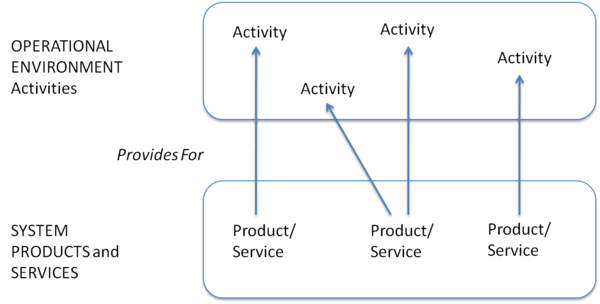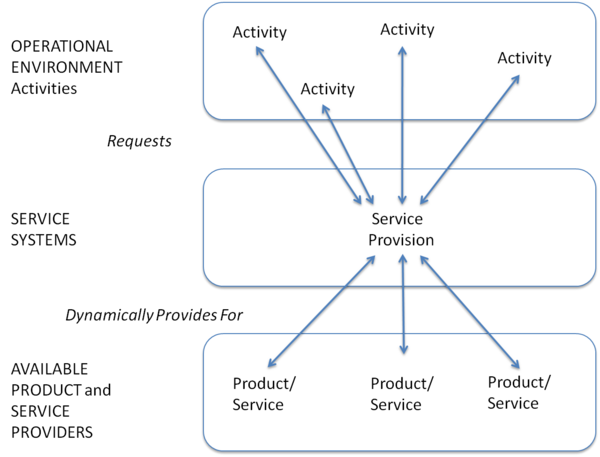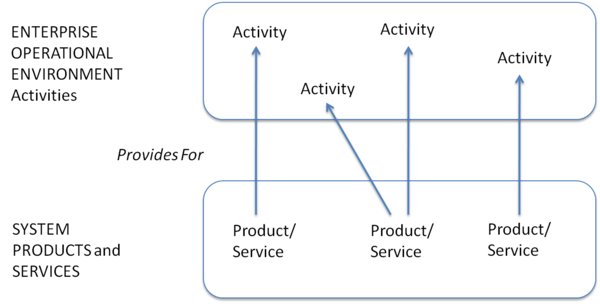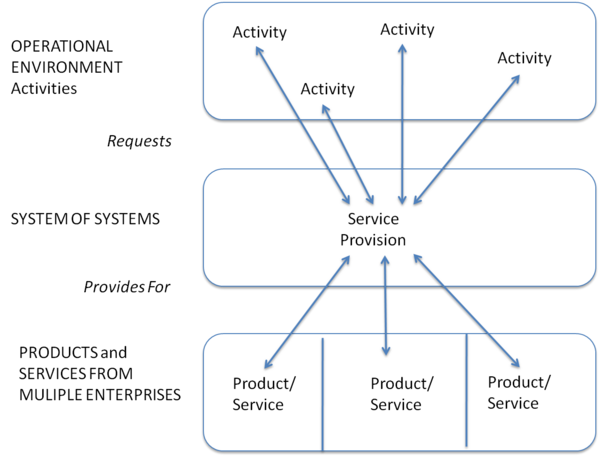Difference between revisions of "Applications of Systems Engineering"
Kguillemette (talk | contribs) m (→References) |
Kguillemette (talk | contribs) |
||
| Line 50: | Line 50: | ||
===Primary References=== | ===Primary References=== | ||
| − | + | ISO/IEC 2008. ''[[ISO/IEC/IEEE 15288|Systems and Software Engineering]] -- System Life Cycle Processes''. Geneva, Switzerland: International Organisation for Standardisation / International Electrotechnical Commissions. ISO/IEC/IEEE 15288:2008. | |
===Additional References=== | ===Additional References=== | ||
Revision as of 14:02, 9 October 2014
This part of the SEBoK focuses on the application of systems engineering to the creation and life cycle management of various types of systems. In particular, the part covers product systems, service systems, enterprise systems, and system of systems (SoS).
Knowledge Areas in Part 4
Each part of the SEBoK is divided into knowledge areas (KAs), which are groupings of information with a related theme. Part 4 contains the following KAs:
- Product Systems Engineering
- Service Systems Engineering
- Enterprise Systems Engineering
- Systems of Systems (SoS)
Systems Engineering Application Paradigms
Part 3, Systems Engineering and Management, introduces a paradigm that identifies the general goal of all systems engineering efforts; that is the transformation of the specific stakeholder need into a system product or service that provides for the need. Given this framework, the various knowledge areas of Part 3 provide deeper insight into how to accomplish activities related to the systems engineering life cycle.
The following paradigms provide a look into the primary similarities and differences of the various applications of systems engineering presented in Part 4. The similarity is that all systems presented in Part 4 are developed to provide for the capabilities needed in an operational environment and these capability needs take form of activities. The supply of the systems and the nature of the operational environment differentiate the applications of systems engineering.
Product System Provisioning
The paradigm in Figure 1 illustrates the main result of traditional systems engineering (TSE), that is, the supply of products and services that fulfill the capability needs as activities in an operational environment. In TSE, the operational environment is often described by some form of the concept of operations (ConOps), which can include use cases of the activities of the system in operation.
It is important to take into account the binding of the products and services to the activities. As implied by the figure, the operational environmental needs are met by directly binding products and/or services to the needs of one or more of the activities of the operational environment. In a manner consistent with ISO/IEC 15288, the products and services are composed of systems in which hardware, software, and human elements are supplied. Thus, a mixture of physical products (often including software) and services, such as logistics, help-desk functions, etc., may be provided. The supply of products and services can be a result of a direct acquisition or the result of acquiring products or services that have been provided for a marketplace. Note that the provisioning of products and services when humans are involved, like in a hospital, may even be classified as sociotechnical systems.
Service System Provisioning
The paradigm in Figure 2 illustrates the provision of service systems. The growth of this model has been stimulated to a large extent due to the widespread availability of IT services, such as service oriented architectures (SOAs), software as a system (SaS), and cloud computing.
A primary difference between service systems engineering (SSE) and TSE is the dynamic binding of products and services, potentially from multiple providers, in order to provide a desired service. Thus, the service is dynamically composed from a given service request. In the background, there are a variety of hardware, software, and even human elements that provide the elements of a service. In contrast to an operational environment that is sustained, the service requested may be viewed as a temporary environment established to provide the service and it disappears after the service has been provided.
Enterprise System Provisioning
The paradigm in Figure 3 illustrates the provision of enterprise systems engineering (ESE) to meet the capability needs in the form of enterprise activities.
This form is similar to TSE except that the activities of the operational environment typically rely upon services provided by systems of processes. Both business processes and system life cycle processes are essential in operating the enterprise. In addition, the products and services that are supplied to the enterprise include those that support their own value added production of products and services, as well as their infrastructure systems.
System of Systems Provisioning
Finally, the paradigm in Figure 4 illustrates the provisioning of products and services by multiple enterprises in forming a SoS that is created to meet the complex needs of an operational environment. Note that this could be meeting a crisis situation or meeting the needs of a new type of operation where multiple enterprises provide a new form of added value based upon their combined products and services.
All of the enterprises that contribute to an SoS are independent and provide value-added products or services that are meaningful individually.
System of systems engineering (SoSE), particularly when responding to some form of natural or man made crisis, is initiated in the form of a request for service in order to meet a complex situation that has come up. In relationship to the system coupling diagram, SoSE involves accelerated engineering of the respondent system that will interact with the situation system. Thus, instantiated system assets in the form of products and/or services are supplied from multiple enterprises and quickly integrated in providing the respondent service. In a manner similar to service systems, the operational environment disappears when the crises has been handled. SoSE is also applied in merging the operations of multiple enterprises in order to provide some new form of service. In contrast to unplanned crises, this is the result of planned development. The formation of the Department of Homeland Security in the USA is an example. In the private sector, multiple organizations may integrate their enterprise operations in order to meet an opportunity in a new marketplace.
References
Works Cited
ISO/IEC 2008. Systems and Software Engineering -- System Life Cycle Processes. Geneva, Switzerland: International Organisation for Standardisation / International Electrotechnical Commissions. ISO/IEC/IEEE 15288:2008.
Primary References
ISO/IEC 2008. Systems and Software Engineering -- System Life Cycle Processes. Geneva, Switzerland: International Organisation for Standardisation / International Electrotechnical Commissions. ISO/IEC/IEEE 15288:2008.
Additional References
None.
SEBoK Discussion
Please provide your comments and feedback on the SEBoK below. You will need to log in to DISQUS using an existing account (e.g. Yahoo, Google, Facebook, Twitter, etc.) or create a DISQUS account. Simply type your comment in the text field below and DISQUS will guide you through the login or registration steps. Feedback will be archived and used for future updates to the SEBoK. If you provided a comment that is no longer listed, that comment has been adjudicated. You can view adjudication for comments submitted prior to SEBoK v. 1.0 at SEBoK Review and Adjudication. Later comments are addressed and changes are summarized in the Letter from the Editor and Acknowledgements and Release History.
If you would like to provide edits on this article, recommend new content, or make comments on the SEBoK as a whole, please see the SEBoK Sandbox.
blog comments powered by Disqus


